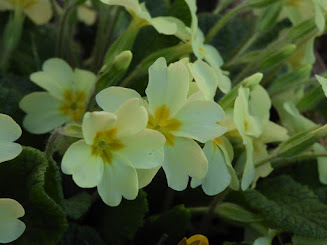The Primrose, Primula vulgaris grows throughout my Wye Valley garden. It only seems to need moisture and some light. Wordsworth wrote in The Primrose of the Rock that "to the rock the root adheres in every fibre true." and that it was "A lasting link in Nature's chain." I give you here the closest I have to a rock: a root thriving in a dry stone wall in said garden! A primrose plant can last for between 15-25 years.
It is a strong plant and can withstand extensive picking. In Devon from the early 1900s thousands were picked and dispatched as gifts to customers of paper mills. The custom was discontinued seventy or so years later in the face of public concern but studies showed little evidence that picking blooms (provided not all were taken) constituted a threat. Habitat changes resulting from land being drained, sprayed or shaded out were significant threats, however. In my own garden a spreading magnolia tree has shaded out the primroses that once grew below it. Luckily there are plenty of other spots for primroses to thrive.
The structure and pollination of the plant were investigated by Darwin who worked quietly on it while controversy raged over his book The Origin of Species. He established the meaning of the structure of the two forms: pin-eyed and thrum-eyed. Apparently nothing in his scientific life had given him more satisfaction than "making out the meaning of the structure of these plants".
This is the pin-eyed form. The pinhead-like stigma is visible in the throat of the flower and the shorter stamens are hidden below in the tube.
Below is the thrum-eyed bloom. The anthers here are higher than the stigma. I was pleased to read an explanation of this term as it is not obvious unless you are familiar with the weaving term for a fringe of loose threads left on the loom after the handwoven cloth has been cut away! Thrum is sometimes also used to refer to a mop head. Understanding dawns as the description is apt!
An early butterfly like the Brimstone, long-tongued early bumble bees like the Garden Bumblebee, and also the Dark-edged Bee-fly can feed on primroses using their long proboscises.The thrum-eyed flower will pollinate the pin-eyed and vice versa because of the mutually advantageous arrangements of anthers, stamens and stigmas at different heights. It was Charles Darwin who first explained this compatibility.
If an insect with a long proboscis visits a pin-eyed flower and reaches for the nectar at the base of the floral tube, then pollen will rub off on its proboscis. If this insect then moves on to a thrum-eyed flower this pollen is at the right height to rub off on the stigma of the thrum-eye bloom. While there, the insect's head will in turn become covered with pollen from the thrum-eyed plant.
When this insect returns to a pin-eyed flower then the pollen on its head will be at the correct height to rub off on the stigma of the pin-eye plant. I am grateful cronodon.com for putting this in simple language for me! Link below to this rather good website.
It doesn't end there! The seed formed has a fleshy protein-rich lump on it which ants like. They take the seeds back to the nest, eat the protein and then deposit the seeds outside the nest. This goes some way to explaining why I have so many primroses near my old fashioned compost heaps in which ants love to nest!
The Primrose, Prima rosa or first rose, has been loved through the centuries. Chaucer compares a lovely woman to a primrose (in Middle English, a prymerole). John Clare accurately observes it "starting up between Dead matted leaves of oak and ash". It was Disraeli's favourite flower and Queen Victoria sent him regular posies from Osborne House and finally a circlet of them for his cortege in 1881.Gerard Manley Hopkins wrote of the returning primrose every year:
As sure as what is most sure, sure as that spring primroses
Shall new-dapple next year, sure as to-morrow morning,
Amongst come-back-again things, things with a revival, things with a recovery....
A message of hope perhaps, across the centuries, in our uncertain times.
I hope you have found the blog interesting. Both Mabey and Stafford have researched the history and botany of this flower extensively.
Acknowledgements
Mabey Flora Britannica
Fiona Stafford The Brief Life of Flowers
Simon Harrap's Wild Flowers
Stace 4
Websites included
http://www.bbc.co.uk/earth/story/20150421-the-true-primrose-displays
http://www.countrysideinfo.co.uk/primrose.htm
http://lifeonanoxfordlawn.blogspot.com/2007/02/primrose-primula-vulgaris.html
https://cronodon.com/NatureTech/primulaceae





Fascinating. Thanks for explaining the derivation of ‘thrum’ and the process of pollination.
ReplyDeleteMy favourite flower.
Rob